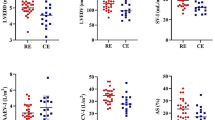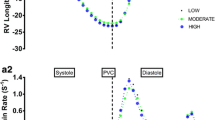Abstract
Athlete’s heart results from physiological adaptations to the increased demands of exercise, and left atrial (LA) enlargement (LAE) is a fundamental component. However, LAE occurs in certain pathological conditions and it might represent a diagnostic challenge in athletes. LA volume index (LAVi) by echo is a convenient diagnostic tool for LAE identification. We hypothesized that accumulated lifetime training thousand hours (LTH) would have a main role in LAE. Therefore, our aim was to assess the association between LTH, LAVi and LAE in athletes. Young and middle-aged males with different training levels were included and grouped as recreational (REa, n = 30), competitive (COa, n = 169) and elite (ELa, n = 80) athletes for LTH calculation and echo assessment. LA dimensions resulted greater in ELa when compared to other groups (p < 0.001). LAVi correlated stronger with LTH than with age (p < 0.001). Polynomial regression analysis showed a non-linear, almost triphasic, effect of cumulative training on LA size (p < 0.02). Multivariate logistic regression, including LTH, age, body surface area, systolic blood pressure and other explanatory variables to predict LAE, showed LTH as the sole significant factor [OR 1.45 (CI 1.1–1.92), p < 0.008]. ROC analysis found an optimal cut off point of 3.6 LTH for LAE identification (AUC = 0.84, p < 0.001. RR = 5.65, p < 0.001). We conclude that LAE associates with LTH more than with other clinical parameters, and with less impact at higher amounts of LTH. Lifetime training greater than 3600 hours increases the probability of finding LAE in athletes. Future research should provide more insights and implications of these findings.




Similar content being viewed by others
References
Fagard R (2003) Athlete’s heart. Heart 89(12):1455–1461
Baggish AL, Wood MJ (2011) Athlete’s heart and cardiovascular care of the athlete: scientific and clinical update. Circulation 123(23):2723–2735
McClean G, George K, Lord R, Utomi V, Jones N et al (2015) Chronic adaptation of atrial structure and function in elite male athletes. Eur Heart J Cardiovasc Imaging 16(4):417–422
Gabrielli L, Bijnens BB, Butakoff C, Duchateau N, Montserrat S et al (2014) Atrial functional and geometrical remodeling in highly trained male athletes: for better or worse? Eur J Appl Physiol 114(6):1143–1152
D’Ascenzi F, Anselmi F, Focardi M, Mondillo S et al (2018) Atrial enlargement in the athlete’s heart: assessment of atrial function may help distinguish adaptive from pathologic remodeling. J Am Soc Echocardiogr 31(2):148–157
Gabrielli L, Enríquez A, Córdova S, Yáñez F, Godoy I et al (2012) Assessment of left atrial function in hypertrophic cardiomyopathy and athlete’s heart: a left atrial myocardial deformation study. Echocardiography 29(8):943–949
Pritchett AM, Jacobsen SJ, Mahoney DW, Rodeheffer RJ, Bailey KR et al (2003) Left atrial volume as an index of left atrial size: a population-based study. J Am Coll Cardiol 41(6):1036–1043
Tsang TS, Abhayaratna WP, Barnes ME, Miyasaka Y, Gersh BJ et al (2006) Prediction of cardiovascular outcomes with left atrial size: is volume superior to area or diameter? J Am Coll Cardiol 47(5):1018–1023
Abhayaratna WP, Seward JB, Appleton CP, Douglas PS, Oh JK et al (2006) Left atrial size: physiologic determinants and clinical applications. J Am Coll Cardiol 47(12):2357–2363
Sanchis-Gomar F, Perez-Quilis C, Lippi G, Cervellin G, Leischik R et al (2017) Atrial fibrillation in highly trained endurance athletes—description of a syndrome. Int J Cardiol 226:11–20
Elosua R, Arquer A, Mont L, Sambola A, Molina L et al (2006) Sport practice and the risk of lone atrial fibrillation: a case-control study. Int J Cardiol 108:332–337
La Gerche A, Schmied CM (2013) Atrial fibrillation in athletes and the interplay between exercise and health. Eur Heart J 34(47):3599–3602
Flannery MD, Kalman JM, Sanders P, La Gerche A (2017) State of the art review: atrial fibrillation in athletes. Heart Lung Circ 26(9):983–989
Drca N, Wolk A, Jensen-Urstad M, Larsson SC (2014) Atrial fibrillation is associated with different levels of physical activity levels at different ages in men. Heart 100(13):1037–1042
Calvo N, Ramos P, Montserrat S, Guasch E, Coll-Vinent B et al (2016) Emerging risk factors and the dose-response relationship between physical activity and lone atrial fibrillation: a prospective case-control study. Europace 18:57–63
D’Ascenzi F, Cameli M, Ciccone MM, Maiello M, Modesti PA et al (2015) The controversial relationship between exercise and atrial fibrillation: clinical studies and pathophysiological mechanisms. J Cardiovasc Med 16:802–810
Lang RM, Badano LP, Mor-Avi V, Afilalo J, Armstrong A et al (2015) Recommendations for cardiac chamber quantification by echocardiography in adults: an update from the American Society of Echocardiography and the European Association of Cardiovascular Imaging. J Am Soc Echocardiogr 28(1):1–39 (e14)
Echocardiographic Normal Ranges Meta-Analysis of the Left heart (EchoNoRMAL) Collaboration (2014) A meta-analysis of echocardiographic measurements of the left heart for the development of normative reference ranges in a large international cohort: the EchoNoRMAL study. Eur Heart J Cardiovasc Imaging 15(3):341–348
Devereux RB (1987) Detection of left ventricular hypertrophy by M-mode echocardiography. Anatomic validation, standardization, and comparison to other methods. Hypertension 9(2 Pt 2):19–26
Narayanan K, Reinier K, Teodorescu C, Uy-Evanado A, Aleong R et al (2014) Left ventricular diameter and risk stratification for sudden cardiac death. J Am Heart Assoc 3(5):e001193
Shan G, Gerstenberger S (2017) Fisher’s exact approach for post hoc analysis of a chisquared test. PLoS ONE 12(12):e0188709
Diedenhofen B, Musch J (2015) Cocor: a comprehensive solution for the statistical comparison of correlations. PLoS ONE 10(4):e0121945
Zou GY (2007) Toward using confidence intervals to compare correlations. Psychol Methods 12:399–413
Goksuluk D, Korkmaz S, Zararsiz G, Karaağaoğlu AE (2016) easyROC: an interactive web-tool for ROC curve analysis using R language environment. R J 8(2):213–230
D’Ascenzi F, Cameli M, Lisi M, Zaca V, Natali B et al (2012) Left atrial remodelling in competitive adolescent soccer players. Int J Sports Med 33(10):795–801
Gjerdalen GF, Hisdal J, Solberg EE, Andersen TE, Radunovic Z et al (2015) Atrial size and function in athletes. Int J Sports Med 36(14):1170–1176
Pelliccia A, Maron BJ, Di Paolo FM, Biffi A, Quattrini FM et al (2005) Prevalence and clinical significance of left atrial remodeling in competitive athletes. J Am Coll Cardiol 46(4):690–696
D’Andrea A, Riegler L, Cocchia R, Scarafile R, Salerno G et al (2010) Left atrial volume index in highly trained athletes. Am Heart J 159(6):1155–1161
Iskandar A, Mujtaba MT, Thompson PD (2015) Left atrium size in elite athletes. JACC Cardiovasc Imaging 8(7):753–762
D’Ascenzi F, Solari M, Anselmi F, Maffei S, Focardi M et al (2016) Atrial chamber remodelling in healthy pre-adolescent athletes engaged in endurance sports: a study with a longitudinal design. The CHILD study. Int J Cardiol 223:325–330
Huang Z, Fonseca R, Sharman JE, Park C, Chaturvedi N et al (2020) The influence of fitness on exercise blood pressure and its association with cardiac structure in adolescence. Scand J Med Sci Sports 30:1033–1039
Boyd A, Lo Q, Devine K, Tchan MC, Sillence DO et al (2013) Left atrial enlargement and reduced atrial compliance occurs early in Fabry cardiomyopathy. J Am Soc Echocardiogr 26(12):1415–1423
D’Ascenzi F, Piu P, Capone V, Sciaccaluga C, Solari M et al (2019) Reference values of left atrial size and function according to age: should we redefine the normal upper limits? Int J Cardiovasc Imaging 35(1):41–48
D’Ascenzi F, Pelliccia A, Natali MB, Zaca V, Cameli M et al (2014) Morphological and functional adaptation of left and right atria induced by training in highly trained female athletes. Circ Cardiovasc Imaging 7:222–229
D’Ascenzi F, Cameli M, Zaca V, Lisi M, Santoro A et al (2011) Supernormal diastolic function and role of left atrial myocardial deformation analysis by 2D speckle tracking echocardiography in elite soccer players. Echocardiography 28(3):320–326
Sanz-de la Garza M, Grazioli G, Bijnens BH, Sarvari SI, Guasch E et al (2016) Acute, exercise dose-dependent impairment in atrial performance during an endurance race: 2D ultrasound speckle-tracking strain analysis. JACC Cardiovasc Imaging 9(12):1380–1388
D’Ascenzi F, Pelliccia A, Natali BM, Cameli M, Andrei V et al (2015) Increased left atrial size is associated with reduced atrial stiffness and preserved reservoir function in athlete’s heart. Int J Cardiovasc Imaging 31(4):699–705
Acknowledgements
Authors would like to thank Technician Sabrina Pardini and Mariana Soffer for their assistance.
Author information
Authors and Affiliations
Corresponding authors
Ethics declarations
Conflict of interest
The authors declare that they have no conflict of interest.
Additional information
Publisher’s Note
Springer Nature remains neutral with regard to jurisdictional claims in published maps and institutional affiliations.
Rights and permissions
About this article
Cite this article
Diaz Babio, G., Vera Janavel, G., Constantin, I. et al. Atrial size and sports. A great training for a greater left atrium: how much is too much?. Int J Cardiovasc Imaging 37, 981–988 (2021). https://doi.org/10.1007/s10554-020-02082-2
Received:
Accepted:
Published:
Issue Date:
DOI: https://doi.org/10.1007/s10554-020-02082-2




